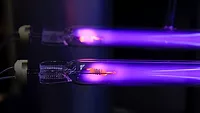James Dipping: Remediation tactics for Legionella outbreaks
What to do if Legionella is found in a plumbing system.

Antonistock/iStock/Getty Images Plus via Getty Images.
My last two columns discussed both chemical and non-chemical additives or technologies that I treat as “must consider” for plumbing engineers in their design practices to reduce the risk of Legionella bacteria developing in the domestic water system. As I mentioned, these topics might not be a code minimum requirement, but as an engineering community, we have a responsibility to uphold the health and safety of the public. Therefore, we should discuss these technologies with our clients for many different building types we come across in our design.
But what happens if Legionella is found in a piping system? You’ll need to take action, and you’ll need to have clear steps on what to do as soon as possible.
Whether you are employing a supplemental disinfection system, or enacting an emergency remediation plan, you’ll need to keep in mind that the Environmental Protection Agency (EPA) plays a very significant role in regulating these systems. They state:
- Adding certain water treatment technologies in a premise plumbing system could impact the chemical and microbial quality of the water and change the regulatory status of the premise plumbing system;
- Facility owners or operators who are considering adding treatment to their building’s premise plumbing system may wish to consult with their water supplier to better understand any potential water quality issues before making treatment-related decisions; and
- In addition to the drinking water regulations under SDWA, manufacturers of pesticidal treatment technologies used to control Legionella and other microbial contaminants need to comply with the Federal Insecticide, Fungicide and Rodenticide Act (FIFRA) requirements, which are independent of the SDWA requirements.
The full resource from the EPA can be found here.
ASPE recently published its “ASPE Engineering Methodologies to Reduce Risk of Legionella in Premises Plumbing Systems.” This is one of the most comprehensive guides engineers can use to understand what technologies are available, and how to properly employ them in design practices. As a working group member of this document, I really encourage everyone in our industry to use it and spread the word to keep our buildings safe.
And now, on to the discussion of emergency remediation tools and tactics…
What is emergency remediation?
Emergency remediation of a premise plumbing system is triggered by a Legionella outbreak associated with a potable water system, identification of suspected cases of the disease associated with a potable water system, identification of Legionella-positive water results during routine environmental testing or failure of control measures. Remediation can apply to not only premise plumbing systems but also cooling towers and evaporative condensers; whirlpool spas; decorative fountains; and other aerosol-generating air coolers, humidifiers and air washers. Documents such as ASHRAE, 2015; HSE, 2014; VHA, 2014; HSE, 2009; CDC, 2003; ASHRAE, 2000 provide guidance on when and how to conduct emergency remediation.
As you can see, there is no “magic bullet” solution available to a facility that has contracted Legionella.
Below are commonly used emergency remediation methods, including superheat-and-flush disinfection, shock hyperchlorination and point-of-use filtration. An emergency remediation plan can use one or any combination of the methods described below. We will be discussing the tools themselves, along with the pros/cons of each for consideration.
Superheat and flush disinfection
The superheat-and-flush disinfection method involves raising the water temperature in the hot water heater sufficiently high to ensure hot water is delivered to outlets; circulating the hot water through all water outlets, faucets, and showerheads; and then flushing with the hot water for a suitable period.
In a building that is newly constructed (and assuming the domestic water system has been turned over “clean” to the new building operators), a constant hot water heater temperature of 140° F (and 130° F at the outlets) is often enough to control (but not necessarily eliminate) Legionella. Many laboratory studies have shown that at 129° F, a 90% (1 log) reduction occurred after 27 minutes. At 137° F, the same reduction took only six minutes. It is important to note; however, that many buildings and existing systems cannot replicate laboratory conditions, and any scale and biofilm can act as a thermal insulator, protecting the bacteria.
Where emergency remediation is required, raising the temperature of hot water tanks to 160° to 170° F and maintaining the piping network such that the water temperature at outlets is greater than 149° F during flushing should is recommended for effective eradication.
These temperatures need to be maintained for an extended period, as the optimal flush time reported varies from 10 to 30 minutes depending on the characteristics of the premise plumbing system. Because of this level of variation, a 30-minute flush time is the most recommended duration.
There are significant considerations that must be taken if choosing the superheat and flush emergency remediation method. Additionally, several limitations of the superheat-and-flush method need to be recognized:
- Superheat-and-flush is only effective when the water temperature at distal outlets reaches the required temperature, and the flushing is conducted for the required time;
- Superheat-and-flush requires sufficient hot water heating capacity. Imagine flushing at full hot water flow for 30 minutes at each outlet in a hospital setting. There likely isn’t a hot water system capable of such demands in existence;
- Superheat-and-flush requires considerable energy and manpower resources;
- Thermal disinfection will not disinfect downstream of and point of use thermostatic mixing valves;
- Scalding is a significant hazard. Caution and close supervision must be taken during emergency disinfection to protect patients, staff and visitors from scalding; and
- Is the infrastructure set up for this method? How much of the building needs to be closed off to allow for adequate flushing to protect from scalding? A full wing? Or pressure zone? Many plumbing designs do not facilitate localized flushing without putting many other users at a high risk of scalding.
There are many journals that will offer recommendations for conducting an effective superheat and flush, but I feel many of them are not practical and do not consider the risks associated with potential liability for scalding of end users and facilities not understanding the extent of the plumbing systems. Superheat and flush can be effective but comes at a very high risk or a very high cost to the hospital.
Hyperchlorination
Hyperchlorination involves injecting chlorine at an elevated concentration into the premise plumbing system in one of two modes: shock or continuous hyperchlorination. Shock hyperchlorination, often used for emergency disinfection, is the injection of chlorine to achieve a level of 20–50 mg/L of free chlorine. After a sufficient contact time, the water is flushed, and the residual chlorine is returned to its normal level. Continuous chlorination (sometimes called continuous hyperchlorination) is accomplished by continuous injection of chlorine to achieve at least 0.5–1.0 mg/L free chlorine. It is often performed as a post-emergency disinfection procedure to aid in the control of Legionella and biofilms.
Hyperchlorination can be applied to the cold- and hot water tanks and to the entire premise plumbing system. It may be the only option in some healthcare facilities where superheat and flush cannot be used because hot water lines are not available at every distal site, or they cannot reach the required high temperature. The success of hyperchlorination in the control of Legionella has been mixed because the efficacy of shock hyperchlorination is affected by the same factors as continuous hyperchlorination, (water quality, temperature, etc.). Shock hyperchlorination, if conducted alone, would not achieve long-term control of Legionella. Researchers have reported that Legionella can be protected within free-living protozoan cysts of Acanthamoebae, which can survive free chlorine concentrations up to 50 mg, which is the high point of concentration for shock chlorination.
Regrowth of Legionella may occur within days or weeks after shock hyperchlorination is discontinued, just as with the superheat-and-flush method. Multiple shock hyperchlorination treatments may be needed in response to positive potable water cultures, followed by continuous hyperchlorination or other treatment measures to achieve long-term results.
Caution must be taken during shock hyperchlorination to avoid exposures to high disinfectant levels. Signs and warning labels should be posted at sinks and other outlets to warn the building occupants not to use the water, which could be very impractical for hospital use.
Shock hyperchlorination of hot and cold-water systems can significantly impact the physical integrity of the piping system and water fixtures if applied incorrectly or too often. Corrosion of metal pipes and appurtenances may occur from exposure to high levels of free chlorine. Therefore, routinely performing these procedures is not recommended.
Point-of-use filtration
POU filtration is defined as the use of a device applied to a single tap for the purpose of reducing contaminants in drinking water at that one tap. POU filtration can be used at specific taps, faucets and showerheads as a temporary measure to provide a physical barrier against Legionella. POU water filtration may be an effective measure for remediation situations if a limited patient area can be targeted. Filters can be installed immediately and are a better alternative than restricting showering and providing bottled water.
Advances in membrane filter technology have resulted in POU filtration systems capable of removing microorganisms. These treatment systems include microfiltration (MF), ultrafiltration (UF), nanofiltration (NF) and reverse osmosis (RO) processes.
POU filters have the potential to concentrate bacteria and foster growth of pathogens if devices are not properly maintained. Failure of filters could lead to the release of high levels of pathogens. Membranes may foul or be degraded by microorganisms.
In general, most POU devices include pre-filtration to treat inlet water and prevent clogging of the central membrane, the central filtration membrane and post-filtration, in a module configuration.
Facility owners and operators are advised to follow the manufacturer’s operational guidance for the POU system being employed. There is a variety of commercially available systems with unique design features and operational conditions. A detailed maintenance log should be kept for each system, based on the state’s requirements, if any. Maintenance typically includes the following:
- Tracking flows — Flow meters are used to measure the total flow treated, as flow values may be used to determine filter membrane or other component replacement parameters;
- Replacement parts — Components should be replaced as required by the manufacturer or monitoring data, to ensure water free of microbial contaminants. Minimal components needing regular replacement include exhausted membranes and pre- and post-filters; and
- Visual check of mechanical conditions — All components, including the mechanical warning device, should be inspected visually on a regular basis and parts replaced/repaired if necessary, in addition to being replaced as specified by the routine replacement schedule.
As you can see, there is no “magic bullet” solution available to a facility that has contracted Legionella. Some manufacturers of copper silver ionization, monochloramine injection and other technologies may lay claim to being able to eradicate Legionella if set points are adjusted. But as you can see, there are many factors that go into how a premise plumbing system works, and therefore, how effective a solution can be. What might work for one facility, might not work for another. It takes experience and knowledge to know how to apply a solution to a facility.
Looking for a reprint of this article?
From high-res PDFs to custom plaques, order your copy today!









